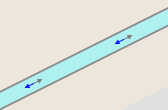Key:oneway:bicycle
 |
| Description |
|---|
| Defines the oneway rules for cyclists. Commonly used to mark a one-way street available for cyclists in both directions. |
| Group: restrictions |
| Used on these elements |
| Documented values: 2 |
| Requires |
|
| Useful combination |
|
| Status: de facto |
| Tools for this tag |
|
Defines the oneway rules for cyclists. oneway:bicycle=no denotes that cyclists may use a one-way street in both directions. If it is not set, the default assumption is that the oneway=* rule for cyclists is identical to those for other modes of transport. The available values are thus similar to oneway:
oneway:bicycle=nomeans that a way is bi-directional for cyclists. It is used when it is indicated by a sign or markings on the street to the same effect (such as bicycle pictograms in contra-flow direction).oneway:bicycle=yesmeans that a way is oneway for cyclists, with allowed passage in its way direction. Usually not needed but can come up on footways which permit bicycles to remove ambiguities on the effect ofoneway=yesfor pedestrians.oneway:bicycle=-1means that the way is oneway for cyclists, with allowed passage opposite to its way direction.
Additionally, a oneway street that has a cycleway going in its contra-flow direction and thus enabling cyclists to use this street in both directions, oneway:bicycle=no is tagged. This however only applies if such a cycleway has been mapped as a property on the oneway street itself (e.g. cycleway:left=lane, not if the cycleway has been mapped as a separate way via highway=cycleway.
Rendering
Deprecated Tags
See Proposal:Deprecate cycleway=opposite family for more details.
See also
cycleway:oneway=*for another case whereoneway=*applies on cyclingoneway:bicycle=no+cycleway:left=lane/cycleway:right=lane/cycleway:both=lanein combination withcycleway:side:oneway=*- if there is a contraflow bicycle laneoneway:bicycle=no+cycleway:left=track/cycleway:right=track/cycleway:both=trackin combination withcycleway:side:oneway=*- if there is a contraflow bicycle trackoneway:moped=*andoneway:mofa=*- exceptions for other single track vechilesoneway:bus=*andoneway:psv=*- exceptions for public transportation vehicles.except=bicycle- Denotes exceptions in turn restrictions- Conditional restrictions - the general tagging framework of which this key is a special case.
